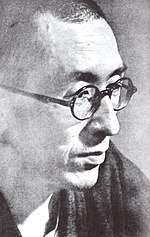Keisuke Serizawa
Keisuke Serizawa (芹沢 銈介, Serizawa Keisuke, May 13, 1895 – April 5, 1984) was a Japanese textile designer. In 1956, he was designated as a Living National Treasure by the Japanese government for his katazome stencil dyeing technique. A leading member of the mingei movement founded by Yanagi Sōetsu, Serizawa visited Okinawa several times and learned the Ryūkyū bingata techniques of dyeing.[1]
Keisuke Serizawa | |
|---|---|
 photographed in 1941 | |
| Born | Keisuke Ōishi May 13, 1895 |
| Died | April 5, 1984 (aged 88) |
| Nationality | Japanese |
| Known for | textile designer |
His folk-art productions included kimono, paper prints, wall scrolls, folding screens, curtains, fans, and calendars. He also produced illustrated books, including Don Quixote, Vincent van Gogh and A Day at Mashiko. In 1981, the Municipal Serizawa Keisuke Art Museum was opened in the city of Shizuoka. Another museum, the Serizawa Keisuke Art and Craft Museum was opened in 1989 in Sendai.
"The distinguishing trait of Serizawa's katazome method is the use of the starch mixture to create, not a colored area as is current in direct-dyeing process, but a blank, undyed one that forms a part of the pattern and that can later be colored by hand in multi-color or monochrome as the designer sees fit."[2]
References
- Joe Earle and Kim Brandt. Serizawa: Master of Japanese Textile Design (Japan Society Series). Yale University Press, 144 pag. 2009 , ISBN 0300150474, ISBN 978-0300150476
- Keisuke Serizawa, The Stencil Artist, Volume 1. Tokyo, Tsukiji Shokan Publishing Company , Ltd., distributed by the Maruzen Co., Ltd, 1967.